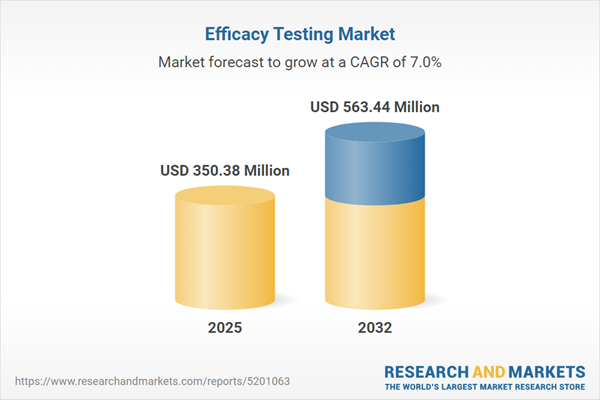Speak directly to the analyst to clarify any post sales queries you may have.
The efficacy testing market is undergoing rapid transformation as regulatory demands shift and organizations seek to strengthen compliance frameworks. Senior leaders must leverage digital innovation and agile validation strategies to ensure operational resilience within increasingly complex and regulated environments.
Efficacy Testing Market Snapshot
The efficacy testing market is experiencing notable expansion, with revenues projected to rise from USD 327.33 million in 2024 to USD 350.38 million in 2025, ultimately reaching USD 563.44 million by 2032. This stable CAGR of 7.02% reflects intensified regulatory oversight and the adoption of advanced validation protocols across sectors. Senior decision-makers are prioritizing digital validation solutions to accelerate product readiness and maintain compliance with evolving standards. As technology adoption widens globally, leadership must continually refine compliance and risk management approaches to retain a competitive edge in the efficacy testing market.
Efficacy Testing Market Scope & Segmentation
This research offers tailored insights, enabling executive teams to enhance compliance strategies, guide digital transformation, and anticipate future regulatory changes. The segmentation framework supports alignment of technology investments and resource deployment with market-specific requirements across diverse applications.
- Component: Investment priorities extend to enhancing physical infrastructure, such as updated servers, storage, and networking equipment, as well as implementation of intelligent software platforms and scalable managed services that address varied compliance needs.
- Deployment Modes: Efficacy testing systems can be configured for public cloud, private cloud, hybrid environments, or on-premise infrastructures. Each deployment model addresses distinct needs for security, privacy management, and regulatory compliance.
- Enterprise Size: Solutions are adaptable for large enterprises and mid-sized organizations, allowing each to tailor processes and compliance frameworks according to operational scope and sector demands.
- Distribution Channels: Procurement options include direct contracting, partnerships with established distributors, and digital commerce platforms, increasing operational flexibility and ease of integration.
- Industry Verticals: Key sectors such as healthcare, pharmaceuticals, public administration, information technology, manufacturing, retail, and financial services require differentiated approaches to validation and governance due to sector-specific regulatory requirements.
- Regions: Regional insights span the Americas, Europe, Middle East and Africa, and Asia-Pacific. Variations in compliance expectations, privacy standards, and supply chain complexities shape uptake and operational strategies across these geographies.
Utilizing real-time monitoring and cloud-enabled architectures, organizations improve audit readiness and adapt swiftly to ongoing regulatory shifts. Segment-level analysis demonstrates how digital transformation and workflow automation drive compliance enhancements across sectors and regions.
Efficacy Testing Market: Key Takeaways for Senior Decision-Makers
- Effective cross-functional collaboration is essential for aligning compliance, clinical, and commercial objectives, enabling organizations to respond efficiently to regulatory policy updates.
- Centralized digital validation platforms streamline audit workflows and centralize the management of compliance documentation, supporting efficiency and traceability.
- Flexible reporting systems provide leaders with actionable intelligence as compliance landscapes shift and business priorities evolve.
- Strengthened governance and strategic oversight simplify supply chain adjustments, ensuring consistent satisfaction of regional regulatory expectations.
- Investments in digital infrastructure enhance agility and help organizations prepare for future regulatory developments.
- Building strong relationships with local and regional suppliers supports continuous compliance management and supply chain stability across operations.
Tariff Impact on Efficacy Testing Programs
Adjustments in international tariffs are encouraging organizations to emphasize local and regional sourcing throughout efficacy testing programs. Expanding supplier qualification and improving due diligence processes reduces dependence on global sources, protecting standards from trade disruptions. These actions contribute to greater supply chain resilience and sustained compliance across varying regulatory frameworks.
Methodology & Data Sources
This analysis combines direct interviews with executives from clinical, regulatory, and procurement functions with market data drawn from peer-reviewed studies, supplier documentation, and recognized white papers. The research approach ensures findings are both actionable and attuned to executive decision-making needs.
Efficacy Testing Market: Why This Report Matters
- Supports leadership in building robust risk management and compliance programs suited to dynamic operational and regulatory contexts.
- Enables seamless coordination among IT, operations, and compliance teams, strengthening governance and responsiveness to market developments.
- Equips senior decision-makers with strategic insights for ongoing regulatory adaptation and market risk assessment.
Conclusion
Organizations that invest in digital validation and agile compliance models are well positioned to navigate evolving regulatory expectations in the efficacy testing market. Focused leadership and strategic planning remain critical for sustaining operational readiness.
Additional Product Information:
- Purchase of this report includes 1 year online access with quarterly updates.
- This report can be updated on request. Please contact our Customer Experience team using the Ask a Question widget on our website.
Table of Contents
3. Executive Summary
4. Market Overview
7. Cumulative Impact of Artificial Intelligence 2025
Companies Mentioned
The companies profiled in this Efficacy Testing market report include:- IQVIA Holdings Inc.
- Laboratory Corporation of America Holdings
- SGS SA
- Eurofins Scientific SE
- Bureau Veritas S.A.
- Intertek Group plc
- Syneos Health, Inc.
- Charles River Laboratories International, Inc.
- ICON plc
- PPD, Inc.
Table Information
| Report Attribute | Details |
|---|---|
| No. of Pages | 195 |
| Published | October 2025 |
| Forecast Period | 2025 - 2032 |
| Estimated Market Value ( USD | $ 350.38 Million |
| Forecasted Market Value ( USD | $ 563.44 Million |
| Compound Annual Growth Rate | 7.0% |
| Regions Covered | Global |
| No. of Companies Mentioned | 11 |









